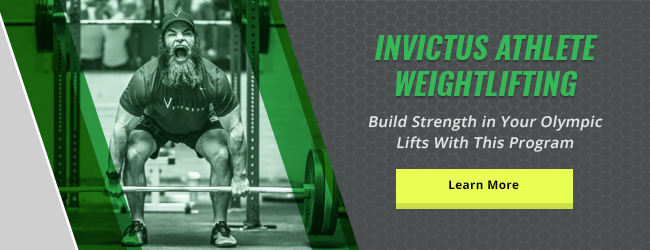Beginner’s Guide to Snatching
Video by Jared Enderton
There’s so much to think about when it comes to snatching, especially when you’re fairly new to the movement. In this video, Invictus Weightlifting Coach, Jared Enderton, shares some key points to help remind you of where your body should be and what you should be focusing on in each phase of the lift.
Establish Grip Width – This will be the same width every time you snatch and overhead squat. When the bar is in the hang position (arms straight and hanging at sides) it should rest in the hip pocket or belt line.
Use Hook Grip – This is where the thumb grips the bar first then the fingers grip the thumb. The hook grip is the strongest grip you can use so even though it can be uncomfortable at first, you’ll be better off in the long run if you can push through the initial discomfort.
Start Position – Stand as close to the bar as you can and squat down to grab ahold in your hook grip. Your shoulders should be stacked on top of the bar, feet hip to shoulder width apart, back set tight and eyes up. Note that this is a slightly different set-up than what you would use for a deadlift – the hips are lower here and it is important that you are looking straight out in front of you and not to the floor.
The Pull – This is the 1st phase of lift from the floor to the mid-thigh. During this portion of the lift, the angle of your back shouldn’t change too drastically and the bar should be moving at a slow and controlled pace as you begin to stand it up. Pull the bar back into you and your knees back into a straighter position. Save your hip extension for the next phase – they shouldn’t open yet which is why your back angle shouldn’t change.
Extension – Also known as the jump or triple extension, is the 2nd phase of the snatch. Once you stand your bar from the floor to mid-thigh (phase 1 – the pull), THEN you will drive your feet into the floor and open your hips as hard as you can while you drive your shoulders back behind you. The bar should fly up because of this effort – make sure to continue to control it toward your body so you don’t lose it out front or behind.
Receiving – This is the 3rd phase of the snatch and should be thought of as more of a PULL UNDER the bar rather than a “catch” of the bar. Meaning, once you throw that bar over your head in phase 2, you can’t just relax and hope to catch it after that. You must quickly move your feet out a little to your squat stance and actively PULL yourself down against the bar and into the strongest overhead squat you can muster. Once you ACTIVELY get to your position, you can keep the bar from crashing down on you by punching up on it. In the bottom of this position, the bar should be slightly behind the ears and directly over the heels. In the beginning, you might need to catch it higher and then ride it down to the bottom. If you do this, hold for 2-3 seconds in the bottom of the squat to help develop both mobility and stability.
No matter what your level, if you want to improve your lifts, you must lift more. Besides executing the particular lift you want to improve, like the snatch, for example, you will get a lot further more quickly if you’re also hitting skill and supplemental work that address each area of the lift and weaknesses in form and technique. Test it out for yourself with Coach Jared’s programing and feedback and a support network of others around the world in the Invictus Weightlifting online program.
